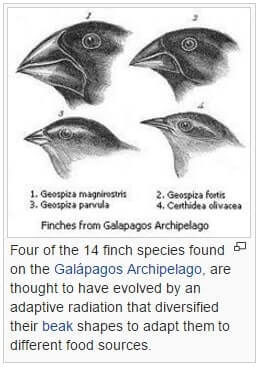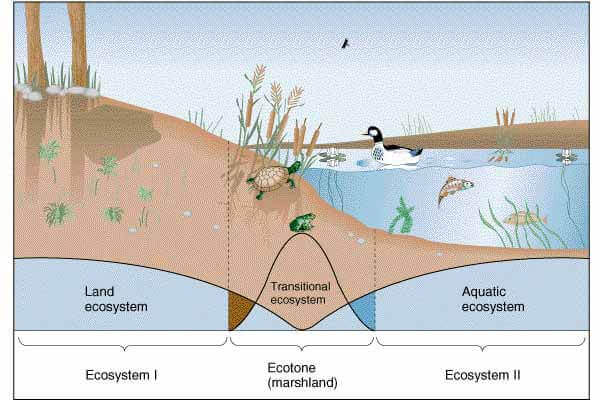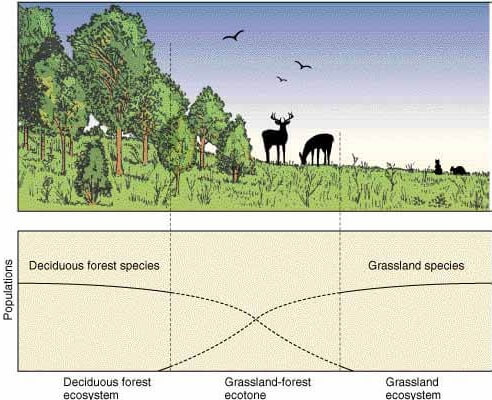Ecology – Principles and Organizations
The term ecology was derived from two Greek words ‘Oikos’ meaning home and ‘logos’ meaning study.
- Ecology is the branch of biology concerned with the relations of organisms to one another (energy flow and mineral cycling) and to their physical surroundings (environment).
- Ecology encompasses the study of individual, organisms, population, community, ecosystem, biome and biosphere which form the various levels of ecological organisation.
- Organism is an individual living being that has the ability to act or function independently.
- Species are a group of living organisms consisting of similar individuals capable of exchanging genes or of interbreeding.
- They are considered as the basic unit of taxonomy and are denoted by a Latin binomial, e.g. Homo sapiens.
- Population is a community of interbreeding organisms (same species), occupying a defined area during a specific time.
- Population growth rate can be positive due to birth and/or immigration or negative due to death and/or emigration.
|
Community
- Communities in most instances are named after the dominant plant form.
- For example, a grassland community is dominated by grasses, though it may contain herbs, trees, etc.
Major Communities
- These are large sized and relatively independent.
- They depend only on the sun’s energy from outside. E.g. Tropical evergreen forests.
- These are dependent on neighbouring communities and are often called societies.
- They are secondary aggregations within a major community. E.g. A mat of lichen on a cow dung pad.
Ecosystem
- An ecosystem is a community of organisms interacting with each other and with their environment such that energy is exchanged and system-level processes, such as the cycling of elements, emerge.
- A biome is a large naturally occurring community of flora and fauna occupying a major habitat. E.g. Rainforest biome or tundra biome.
- Plants and animals in a biome have common characteristics due to similar climates and can be found over a range of continents.
- Biomes are distinct from habitats because any biome can comprise a variety of habitats.
- The biosphere includes all living organisms on earth, together with the dead organic matter produced by them.
Adaptation
- An adaptation is, “the appearance or behaviour or structure or mode of life of an organism that allows it to survive in a particular environment”.
- Morphological – when trees grew higher, the giraffe’s neck got longer;
- Physiological – in the absence of an external source of water, the kangaroo rat in North American deserts is capable of meeting all its water requirements through its internal fat oxidation (in which water is a by-product). It also has the ability to concentrate its urine so that minimal volume of water is used to remove excretory products;
- Behavioural – animals migrating temporarily to a less stressful habitat.
- Many desert plants have a thick cuticle on their leaf surfaces and have their stomata arranged in deep pits to minimise water loss through transpiration.
- Some desert plants like Opuntia, have no leaves – they are reduced to spines, and the photosynthetic function is taken over by the flattened stems (few leaves mean less area is available for transpiration).
- Mammals from colder climates generally have shorter ears and limbs to minimise heat loss. (This is called Allen’s Rule.) Guess why an elephant has huge ears?
- We need to breathe faster when we are on high mountains. After some days, our body adjusts to the changed conditions on the high mountain.
- Such small changes that take place in the body of a single organism over short periods, to overcome small problems due to changes in the surroundings, are called acclimatisation.
- The body compensates low oxygen availability by increasing red blood cell production, decreasing the binding capacity of haemoglobin and by increasing breathing rate.
- A hyperthermophile is an organism that thrives in extremely hot environments — from 60 °C. E.g. Archaebacteria flourish in hot springs and deep-sea hydrothermal vents.
- Desert lizards lack the physiological ability that mammals have. They bask in the sun and absorb heat when their body temperature drops but move into the shade when the ambient temperature starts increasing.
- Some species are capable of burrowing into the soil to hide and escape from the above-ground heat.
- Variations are induced by changes in genetic makeup due to addition or deletion of certain genes.
- Mutations, change in climate, geographical barriers etc. induce variations over a period of time.
- The difference in the colour of skin, type of hair; curly or straight, eye colour, blood type among different ethnic groups represents variation within human species.
- Adaptive radiation is a process in which organisms diversify from an ancestral species into a multitude of new forms when the environment creates new challenges or opens new environmental niches.
 Speciation
Speciation- Speciation is the process by which new species are formed, and evolution is the mechanism by which speciation is brought about.
- A species comprises of many populations. Often different populations of a species remain isolated due to some geographic barrier such as mountain, ocean, river, etc.
- Geographic isolation leads to speciation (allopatric speciation or geographic speciation).
- After a long period of time, the sub-populations become very different (genetic drift) and get isolated, reproductively, i.e. they no longer interbreed.
- Later even when the barrier is removed, the sub-populations are unable to interbreed, and thus subsequently the sub-populations become two different species.
- Mutation (a change in genetic material that results from an error in replication of DNA) causes new genes to arise in a population.
- Further, in a sexually reproducing population, meiosis and fertilisation produce a new combination of genes every generation, which is termed recombination.
- Thus, members of the same species show ‘variation’ and are not identical.
- Natural Selection is the mechanism proposed by Darwin and Wallace.
- Natural selection is the process by which species adapt to their environment.
- It is an evolutionary force that selects among variations, i.e. genes that help the organism to better adapt to its environment. Such genes are reproduced more in a population due to natural selection.
- Those offsprings which are suited to their immediate environment have a better chance of surviving, reaching reproductive age and passing on the suitable adaptations to their progeny.
- Evolution is the change which gives rise to new species.
- It happens in order to make the organism better suitable to the present environment.
- Evolution involves the processes of natural selection, adaptation, variation etc.
- A valid theory of evolution was propounded by Charles Darwin and Alfred Wallace in 1859.
- This theory has been extended in the light of progress in genetics and is known as Neo-Darwinism.
- The primary reason behind extinctions is environmental change or biological competition.
- Extinction occurs when species cannot evolve fast enough to cope with the changing environment.
- At present, the 6th Mass Extinction (Anthropogenic Extinction – human induced) is in progress.
Ecotone: Edge Effect, Edge Species and Ecological Niche
Environment Ecotone: Edge Effect, Edge Species and Ecological Niche
- Ecotone is a zone of junction or a transition area between two biomes (diverse ecosystems).
- Ecotone is the zone where two communities meet and integrate.
- For e.g. the mangrove forests represent an ecotone between marine and terrestrial ecosystem.
- Other examples are grassland (between forest and desert), estuary (between fresh water and salt water) and riverbank or marshland (between dry and wet).

 Characteristics of Ecotone
Characteristics of Ecotone- It may be narrow (between grassland and forest) or wide (between forest and desert).
- It has conditions intermediate to the adjacent ecosystems. Hence it is a zone of tension.
- Usually, the number and the population density of the species of an outgoing community decreases as we move away from the community or ecosystem.
- A well-developed ecotone contains some organisms which are entirely different from that of the adjoining communities.
Ecocline
- Ecocline is a zone of gradual but continuous change from one ecosystem to another when there is no sharp boundary between the two in terms of species composition.
- Ecocline occurs across the environmental gradient (gradual change in abiotic factors such as altitude, temperature (thermocline), salinity (halocline), depth, etc.).
Edge Effect – Edge Species
- Edge effect refers to the changes in population or community structures that occur at the boundary of two habitats (ecotone).
- Sometimes the number of species and the population density of some of the species in the ecotone is much greater than either community. This is called edge effect.
- The organisms which occur primarily or most abundantly in this zone are known as edge species.
- In the terrestrial ecosystems edge effect is especially applicable to birds.
- For example, the density of birds is greater in the ecotone between the forest and the desert.
Ecological Niche
- Niche refers to the unique functional role and position of a species in its habitat or ecosystem.
- The functional characteristics of a species in its habitat is referred to as “niche” in that common habitat.
- In nature, many species occupy the same habitat, but they perform different functions:
- habitat niche – where it lives, food niche – what is eats or decomposes & what species it competes with,
- reproductive niche – how and when it reproduces,
- physical & chemical niche – temperature, land shape, land slope, humidity & another requirement.
- Niche plays an important role in the conservation of organisms. If we have to conserve species in its native habitat, we should have knowledge about the niche requirements of the species.
Difference between niche and habitat
- The habitat of a species is like its ‘address’ (i.e. where it lives) whereas niche can be thought of as its “profession” (i.e. activities and responses specific to the species).
- A niche is unique for a species while many species share the habitat.
- No two species in a habitat can have the same niche. This is because of the competition with one another until one is displaced.
- For example, a large number of different species of insects may be pests of the same plant, but they can co-exist as they feed on different parts of the same plant.
- Home Range – A home range is an area in which an animal lives and moves on a daily or periodic basis (a little bigger than habitat – home → office → home).






